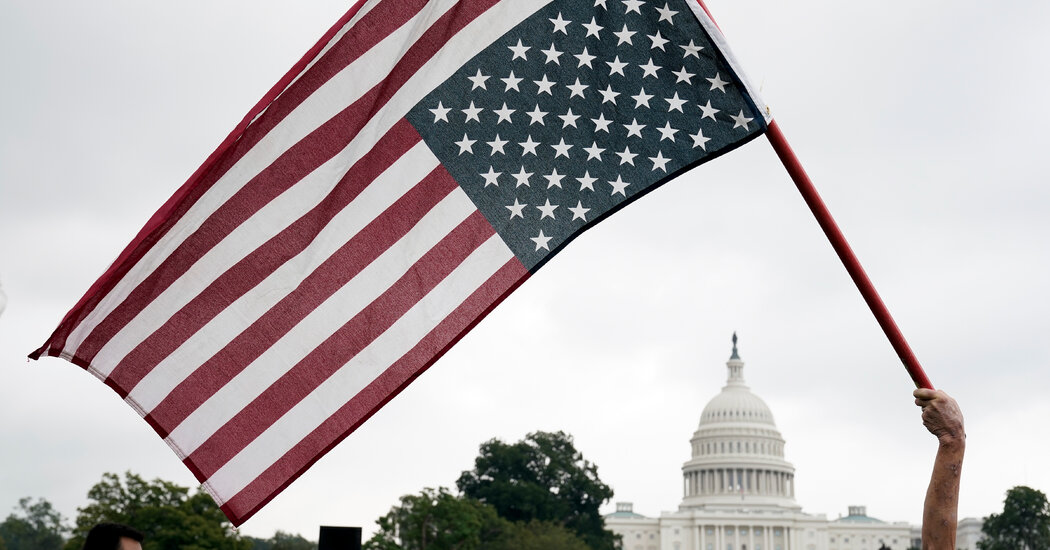
It has been a widely recognized symbol of distress since the nation’s founding, when sailors turned the American flag upside down to signal that their ships were sinking, on fire or trapped in ice.
But over time, the upside-down American flag became a symbol brandished more often by protesters across the political spectrum to signal that they believed the nation itself was in grave peril.
After President Biden won the 2020 election, supporters of former President Donald J. Trump rallied around the inverted flag, displaying it at their homes, on their cars and on social media to show that they believed Mr. Trump’s lie that the election was stolen. Some began doing so before the votes were even counted.
Now, the practice has burst into the national conversation after The New York Times reported on Thursday that it had recently obtained images of an upside-down flag flying outside the home in Alexandria, Va., of Justice Samuel A. Alito Jr. in January 2021. At the time, the Supreme Court was still contending with whether to hear a 2020 election case.
Justice Alito said in an email to The Times that he had “no involvement whatsoever in the flying of the flag.”
“It was briefly placed by Mrs. Alito in response to a neighbor’s use of objectionable and personally insulting language on yard signs,” he wrote, referring to his wife, Martha-Ann Alito.
Flying an inverted flag was once a call for help at sea.
Before it became an emblem of political protest, flying a nation’s flag upside-down was one of the only ways for sailors to call for help.
The practice seems to have originated in the British Isles in the 17th century, likely during the Anglo-Dutch wars, according to the North American Vexillological Association, a group dedicated to the study of flags.
Ted Kaye, the association’s secretary, said he had seen 18th-century engravings of the American flag flying upside down on lifeboats and on New England whaling vessels locked in ice. “It was the easiest way to signal distress without having any special flag,” Mr. Kaye said, “and distress is the most urgent signal that one might want to send from a ship.”
That meaning was reflected in the U.S. flag code, an official set of guidelines for the flag, which was first published in the 1920s. It reads: “The flag should never be displayed with the union down, except as a signal of dire distress in instances of extreme danger to life or property.”
The convention endured for decades. In 1974, a 67‐year‐old clam digger named Julius Novickis flew the inverted flag after he suffered a stroke on a barren island off Nassau County, on Long Island, and successfully summoned a police helicopter.
It has been used to protest slavery and the Vietnam War.
The upside-down flag also has a long history as a political emblem.
In 1854, Henry David Thoreau delivered a scathing antislavery speech while standing under an upside-down American flag on a stage with Sojourner Truth and William Lloyd Garrison, who held up a copy of the Constitution and set it on fire to jeers and groans from the audience, according to “Henry David Thoreau: A Life,” by Laura Dassow Walls.
In the 1960s and ’70s, protesters carried the flag upside-down as a symbol of opposition to the Vietnam War, said Marc Leepson, the author of “Flag: An American Biography.” Some put flag stamps upside down on their letters, sending a subtler antiwar message, he said.
A backlash sometimes ensued.
In his first campaign for Congress in 1972, John F. Kerry, the Vietnam veteran turned antiwar activist who went on to become a Democratic senator from Massachusetts, presidential nominee and secretary of state, was bitterly attacked for having published a book, “The New Soldier,” with a cover that showed a group of bearded veterans holding the American flag upside down.
The Kerry congressional campaign tried to explain the flag’s position as the international signal of distress. He lost that election.
Robert Justin Goldstein, a professor emeritus of political science at Oakland University in Rochester, Mich., said that before Supreme Court ruled in 1989 that burning the American flag was protected under the First Amendment, some Americans were prosecuted for turning the flag upside down.
It was considered desecration of the flag, he said.
In more recent years, the inverted flag has been displayed by Tea Party activists who opposed the re-election of President Barack Obama and by protesters demonstrating after Michael Brown, a teenager, was shot and killed by a police officer in Ferguson, Mo., in 2014. In 2020, an Associated Press photo of a protester carrying a U.S. flag upside down next to a burning building in Minneapolis circulated widely, capturing the fire and fury in that city after the murder of George Floyd at the hands of police officers.
It is now associated with the ‘Stop the Steal’ movement, which denies Donald Trump’s 2020 defeat.
In 2020, the upside-down flag became more firmly established as an emblem of Trump supporters who denied the legitimacy of Mr. Biden’s victory, said Alex Newhouse, a researcher at the University of Colorado, Boulder.
“It’s very, very common in MAGA communities and QAnon communities,” he said. “It caught on among hard-core MAGA people in the ‘Stop the Steal’ ecosystem in 2020.”
Matthew Guterl, a professor of Africana Studies and American Studies at Brown University, said that flying the flag upside-down “seems to have become a part of our hyperpartisan symbolic surround, especially on the right, where it symbolizes the impending death of the nation and a call to arms.”
Other symbols include thin-blue-line flags, a pro-police symbol, and a Punisher skull, based on the comic-book vigilante, he said.
“I’m sure if a Navy skiff hung its flag upside-down, anyone who saw it would assume calamity and come running to help,” he said in an email. “But the meaning of things is also sticky. Once the flag is associated with the right’s call to arms, it is likely to adhere for a long time.”
Jodi Kantor contributed reporting and Alain Delaquérière contributed research.





